SAP101: Analysis of Aged Care Policy in Australian Society
VerifiedAdded on 2023/06/11
|9
|1713
|261
Report
AI Summary
This report provides a comprehensive overview of Australia's aged care policy, tracing its historical development from the early 20th century to the present day. It examines key changes and reforms implemented over the years, driven by factors such as an aging population and evolving societal needs. The report highlights the impact of these policies on the lives of older Australians, including access to healthcare, home support services, and residential care facilities. It also discusses the government's vision for a sustainable and affordable aged care system that promotes independence, choice, and quality of life for older adults. The analysis includes references to relevant legislation, government initiatives, and scholarly research, offering a holistic understanding of the complexities and challenges within the Australian aged care sector. Desklib provides access to this report and many other resources for students.
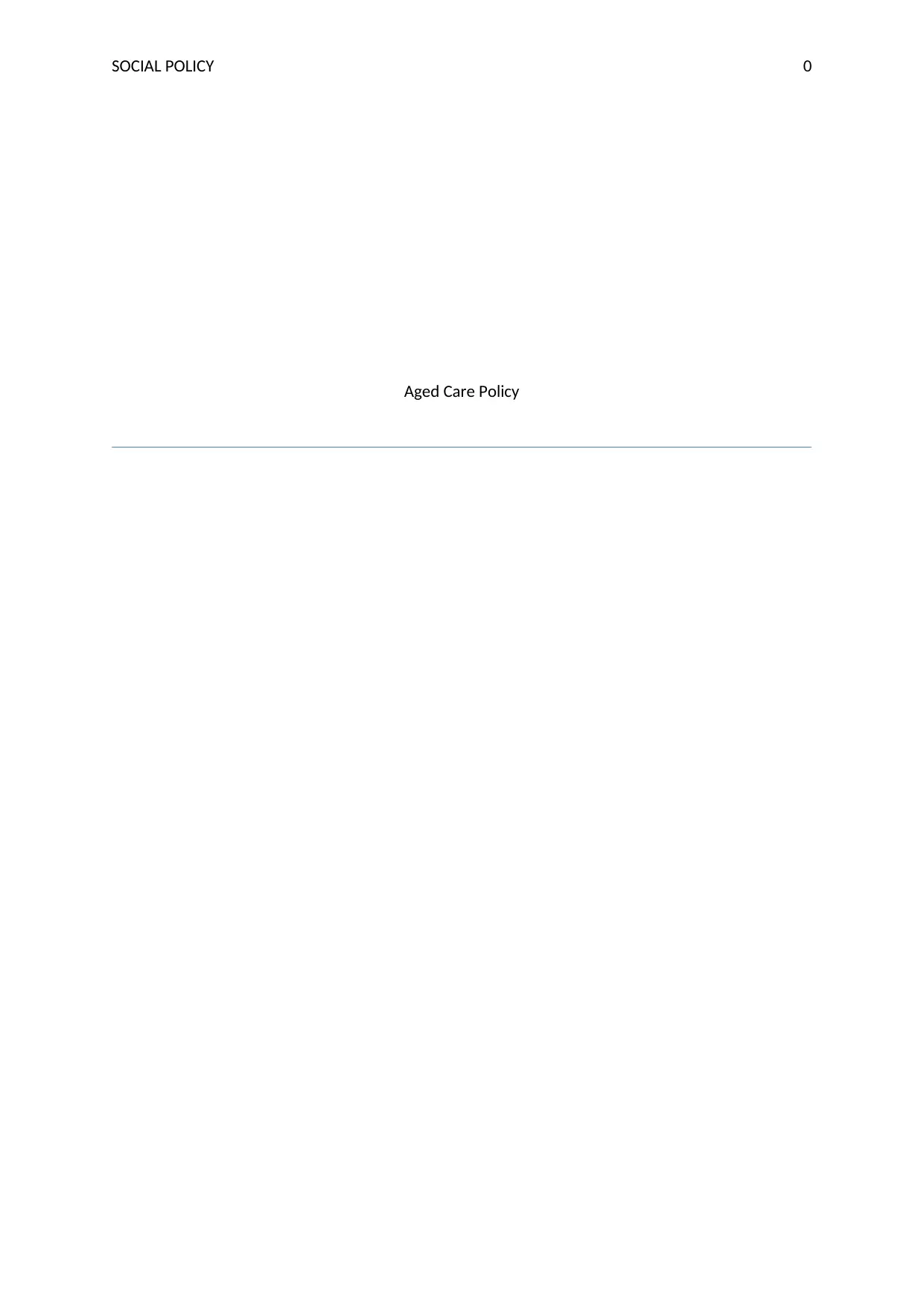
SOCIAL POLICY 0
Aged Care Policy
Aged Care Policy
Paraphrase This Document
Need a fresh take? Get an instant paraphrase of this document with our AI Paraphraser
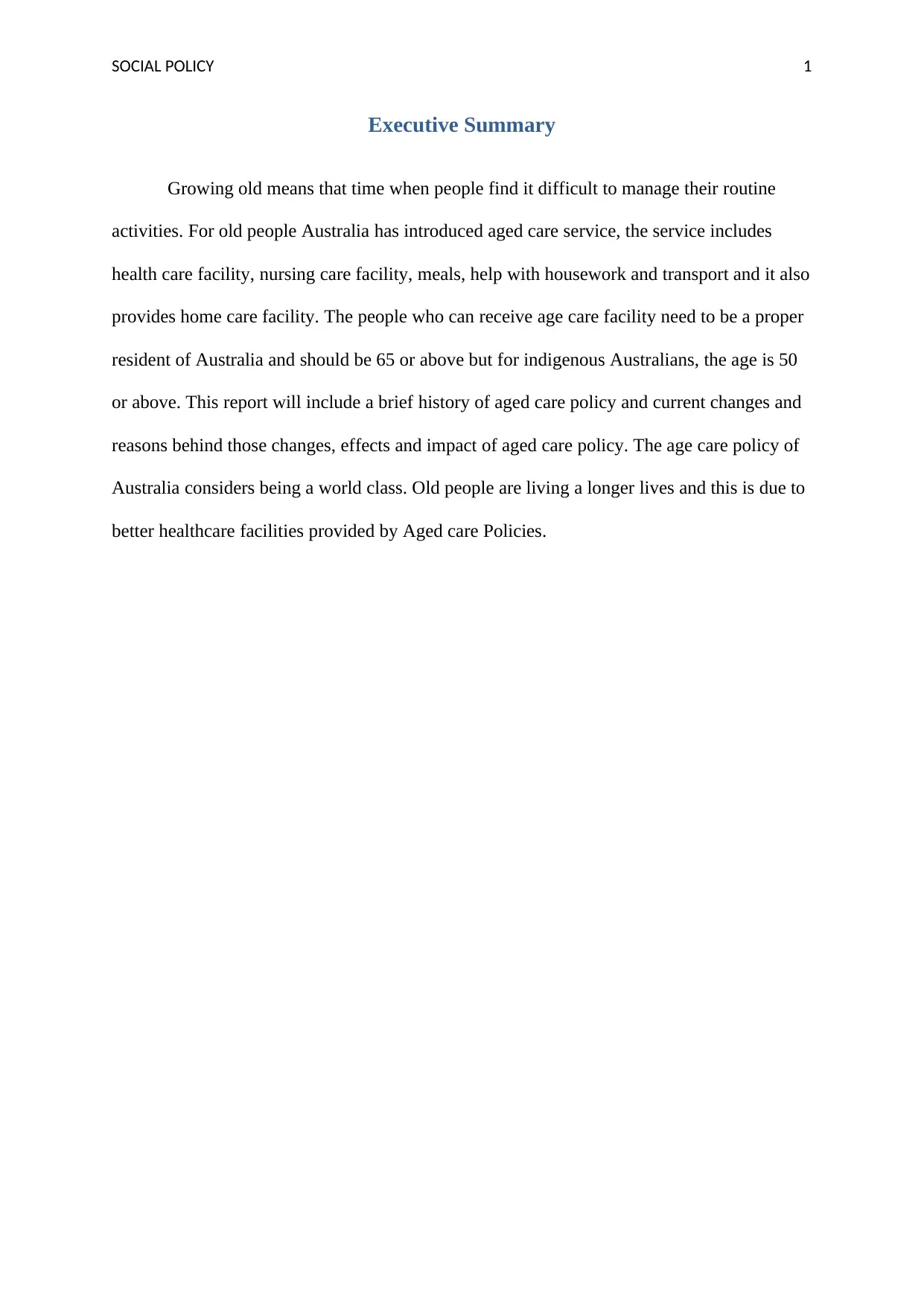
SOCIAL POLICY 1
Executive Summary
Growing old means that time when people find it difficult to manage their routine
activities. For old people Australia has introduced aged care service, the service includes
health care facility, nursing care facility, meals, help with housework and transport and it also
provides home care facility. The people who can receive age care facility need to be a proper
resident of Australia and should be 65 or above but for indigenous Australians, the age is 50
or above. This report will include a brief history of aged care policy and current changes and
reasons behind those changes, effects and impact of aged care policy. The age care policy of
Australia considers being a world class. Old people are living a longer lives and this is due to
better healthcare facilities provided by Aged care Policies.
Executive Summary
Growing old means that time when people find it difficult to manage their routine
activities. For old people Australia has introduced aged care service, the service includes
health care facility, nursing care facility, meals, help with housework and transport and it also
provides home care facility. The people who can receive age care facility need to be a proper
resident of Australia and should be 65 or above but for indigenous Australians, the age is 50
or above. This report will include a brief history of aged care policy and current changes and
reasons behind those changes, effects and impact of aged care policy. The age care policy of
Australia considers being a world class. Old people are living a longer lives and this is due to
better healthcare facilities provided by Aged care Policies.

SOCIAL POLICY 2
Contents
Introduction................................................................................................................................3
History of Aged Care Policy......................................................................................................3
Changes and reason behind changes in Aged Care Policy........................................................4
Effect and Impact of Aged Care Policy.....................................................................................5
Conclusion..................................................................................................................................6
References..................................................................................................................................7
Contents
Introduction................................................................................................................................3
History of Aged Care Policy......................................................................................................3
Changes and reason behind changes in Aged Care Policy........................................................4
Effect and Impact of Aged Care Policy.....................................................................................5
Conclusion..................................................................................................................................6
References..................................................................................................................................7
⊘ This is a preview!⊘
Do you want full access?
Subscribe today to unlock all pages.

Trusted by 1+ million students worldwide
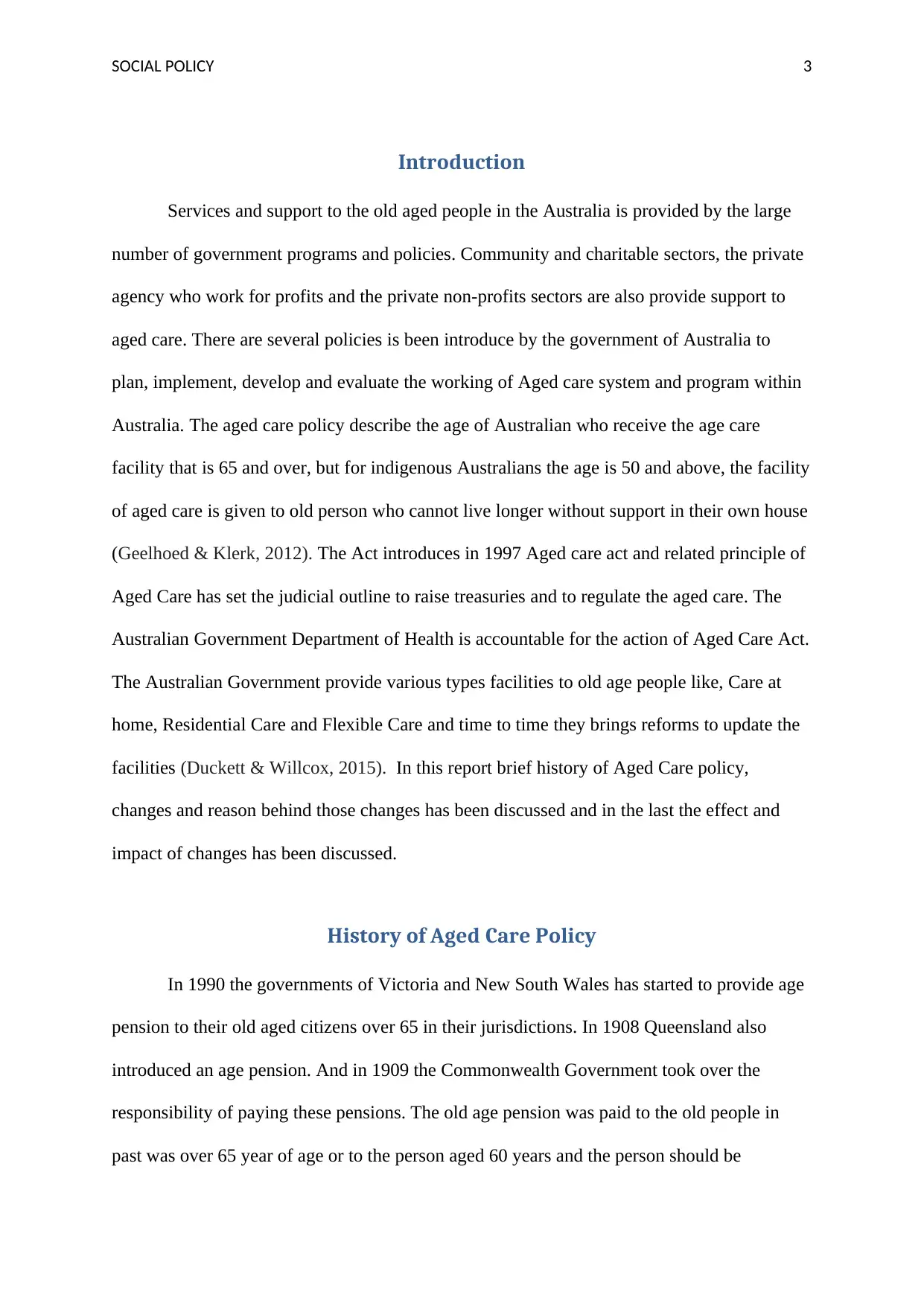
SOCIAL POLICY 3
Introduction
Services and support to the old aged people in the Australia is provided by the large
number of government programs and policies. Community and charitable sectors, the private
agency who work for profits and the private non-profits sectors are also provide support to
aged care. There are several policies is been introduce by the government of Australia to
plan, implement, develop and evaluate the working of Aged care system and program within
Australia. The aged care policy describe the age of Australian who receive the age care
facility that is 65 and over, but for indigenous Australians the age is 50 and above, the facility
of aged care is given to old person who cannot live longer without support in their own house
(Geelhoed & Klerk, 2012). The Act introduces in 1997 Aged care act and related principle of
Aged Care has set the judicial outline to raise treasuries and to regulate the aged care. The
Australian Government Department of Health is accountable for the action of Aged Care Act.
The Australian Government provide various types facilities to old age people like, Care at
home, Residential Care and Flexible Care and time to time they brings reforms to update the
facilities (Duckett & Willcox, 2015). In this report brief history of Aged Care policy,
changes and reason behind those changes has been discussed and in the last the effect and
impact of changes has been discussed.
History of Aged Care Policy
In 1990 the governments of Victoria and New South Wales has started to provide age
pension to their old aged citizens over 65 in their jurisdictions. In 1908 Queensland also
introduced an age pension. And in 1909 the Commonwealth Government took over the
responsibility of paying these pensions. The old age pension was paid to the old people in
past was over 65 year of age or to the person aged 60 years and the person should be
Introduction
Services and support to the old aged people in the Australia is provided by the large
number of government programs and policies. Community and charitable sectors, the private
agency who work for profits and the private non-profits sectors are also provide support to
aged care. There are several policies is been introduce by the government of Australia to
plan, implement, develop and evaluate the working of Aged care system and program within
Australia. The aged care policy describe the age of Australian who receive the age care
facility that is 65 and over, but for indigenous Australians the age is 50 and above, the facility
of aged care is given to old person who cannot live longer without support in their own house
(Geelhoed & Klerk, 2012). The Act introduces in 1997 Aged care act and related principle of
Aged Care has set the judicial outline to raise treasuries and to regulate the aged care. The
Australian Government Department of Health is accountable for the action of Aged Care Act.
The Australian Government provide various types facilities to old age people like, Care at
home, Residential Care and Flexible Care and time to time they brings reforms to update the
facilities (Duckett & Willcox, 2015). In this report brief history of Aged Care policy,
changes and reason behind those changes has been discussed and in the last the effect and
impact of changes has been discussed.
History of Aged Care Policy
In 1990 the governments of Victoria and New South Wales has started to provide age
pension to their old aged citizens over 65 in their jurisdictions. In 1908 Queensland also
introduced an age pension. And in 1909 the Commonwealth Government took over the
responsibility of paying these pensions. The old age pension was paid to the old people in
past was over 65 year of age or to the person aged 60 years and the person should be
Paraphrase This Document
Need a fresh take? Get an instant paraphrase of this document with our AI Paraphraser
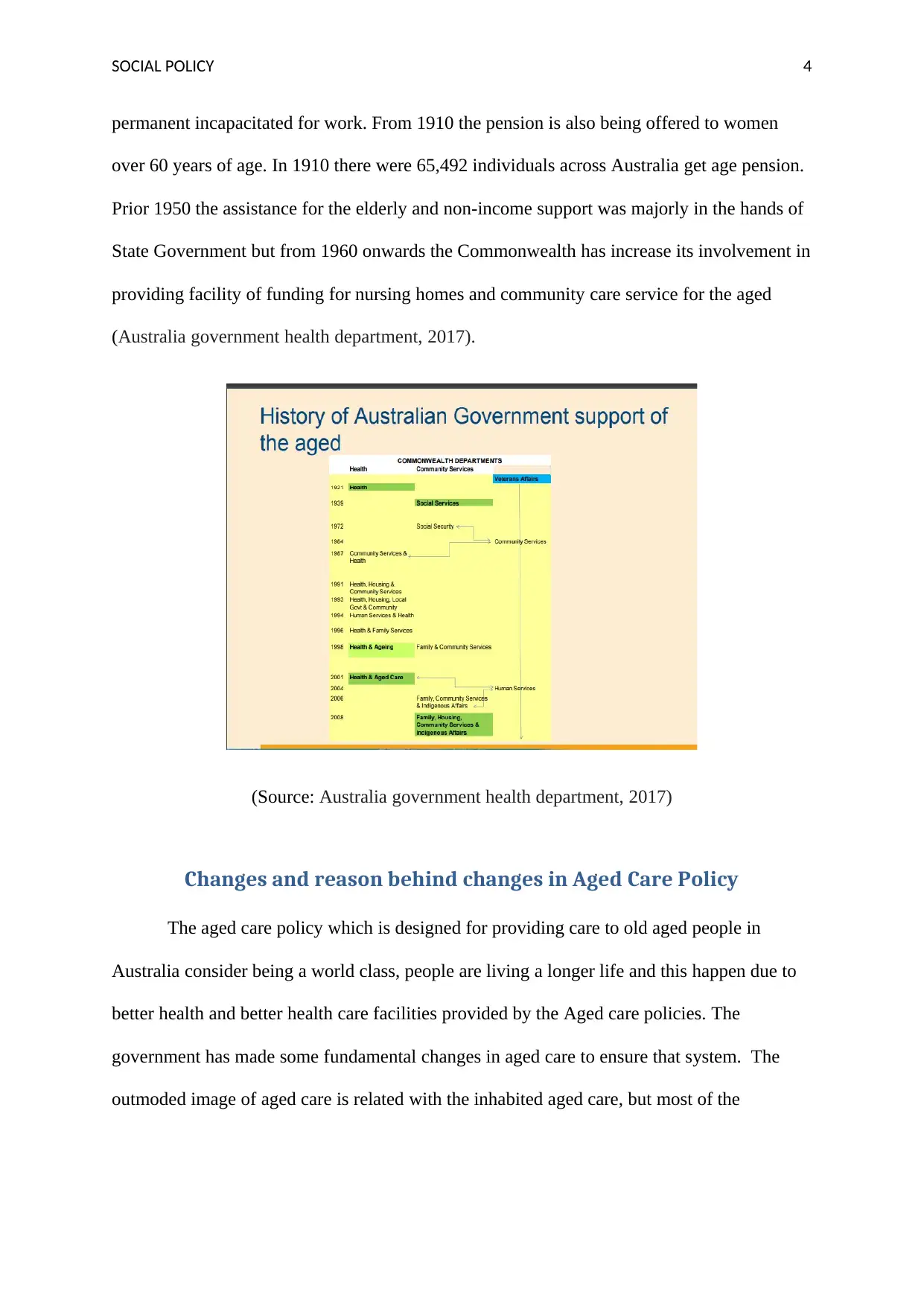
SOCIAL POLICY 4
permanent incapacitated for work. From 1910 the pension is also being offered to women
over 60 years of age. In 1910 there were 65,492 individuals across Australia get age pension.
Prior 1950 the assistance for the elderly and non-income support was majorly in the hands of
State Government but from 1960 onwards the Commonwealth has increase its involvement in
providing facility of funding for nursing homes and community care service for the aged
(Australia government health department, 2017).
(Source: Australia government health department, 2017)
Changes and reason behind changes in Aged Care Policy
The aged care policy which is designed for providing care to old aged people in
Australia consider being a world class, people are living a longer life and this happen due to
better health and better health care facilities provided by the Aged care policies. The
government has made some fundamental changes in aged care to ensure that system. The
outmoded image of aged care is related with the inhabited aged care, but most of the
permanent incapacitated for work. From 1910 the pension is also being offered to women
over 60 years of age. In 1910 there were 65,492 individuals across Australia get age pension.
Prior 1950 the assistance for the elderly and non-income support was majorly in the hands of
State Government but from 1960 onwards the Commonwealth has increase its involvement in
providing facility of funding for nursing homes and community care service for the aged
(Australia government health department, 2017).
(Source: Australia government health department, 2017)
Changes and reason behind changes in Aged Care Policy
The aged care policy which is designed for providing care to old aged people in
Australia consider being a world class, people are living a longer life and this happen due to
better health and better health care facilities provided by the Aged care policies. The
government has made some fundamental changes in aged care to ensure that system. The
outmoded image of aged care is related with the inhabited aged care, but most of the
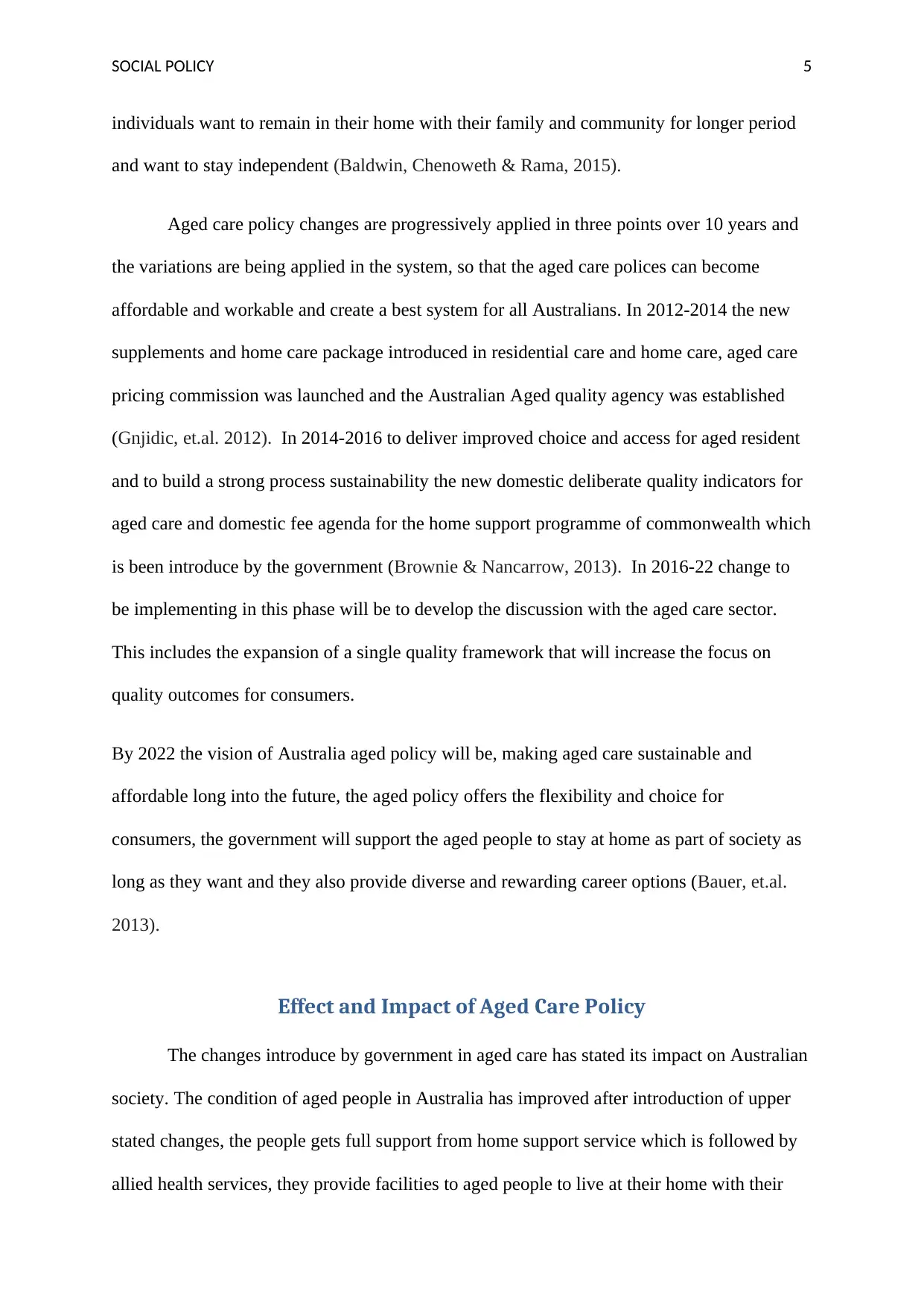
SOCIAL POLICY 5
individuals want to remain in their home with their family and community for longer period
and want to stay independent (Baldwin, Chenoweth & Rama, 2015).
Aged care policy changes are progressively applied in three points over 10 years and
the variations are being applied in the system, so that the aged care polices can become
affordable and workable and create a best system for all Australians. In 2012-2014 the new
supplements and home care package introduced in residential care and home care, aged care
pricing commission was launched and the Australian Aged quality agency was established
(Gnjidic, et.al. 2012). In 2014-2016 to deliver improved choice and access for aged resident
and to build a strong process sustainability the new domestic deliberate quality indicators for
aged care and domestic fee agenda for the home support programme of commonwealth which
is been introduce by the government (Brownie & Nancarrow, 2013). In 2016-22 change to
be implementing in this phase will be to develop the discussion with the aged care sector.
This includes the expansion of a single quality framework that will increase the focus on
quality outcomes for consumers.
By 2022 the vision of Australia aged policy will be, making aged care sustainable and
affordable long into the future, the aged policy offers the flexibility and choice for
consumers, the government will support the aged people to stay at home as part of society as
long as they want and they also provide diverse and rewarding career options (Bauer, et.al.
2013).
Effect and Impact of Aged Care Policy
The changes introduce by government in aged care has stated its impact on Australian
society. The condition of aged people in Australia has improved after introduction of upper
stated changes, the people gets full support from home support service which is followed by
allied health services, they provide facilities to aged people to live at their home with their
individuals want to remain in their home with their family and community for longer period
and want to stay independent (Baldwin, Chenoweth & Rama, 2015).
Aged care policy changes are progressively applied in three points over 10 years and
the variations are being applied in the system, so that the aged care polices can become
affordable and workable and create a best system for all Australians. In 2012-2014 the new
supplements and home care package introduced in residential care and home care, aged care
pricing commission was launched and the Australian Aged quality agency was established
(Gnjidic, et.al. 2012). In 2014-2016 to deliver improved choice and access for aged resident
and to build a strong process sustainability the new domestic deliberate quality indicators for
aged care and domestic fee agenda for the home support programme of commonwealth which
is been introduce by the government (Brownie & Nancarrow, 2013). In 2016-22 change to
be implementing in this phase will be to develop the discussion with the aged care sector.
This includes the expansion of a single quality framework that will increase the focus on
quality outcomes for consumers.
By 2022 the vision of Australia aged policy will be, making aged care sustainable and
affordable long into the future, the aged policy offers the flexibility and choice for
consumers, the government will support the aged people to stay at home as part of society as
long as they want and they also provide diverse and rewarding career options (Bauer, et.al.
2013).
Effect and Impact of Aged Care Policy
The changes introduce by government in aged care has stated its impact on Australian
society. The condition of aged people in Australia has improved after introduction of upper
stated changes, the people gets full support from home support service which is followed by
allied health services, they provide facilities to aged people to live at their home with their
⊘ This is a preview!⊘
Do you want full access?
Subscribe today to unlock all pages.

Trusted by 1+ million students worldwide
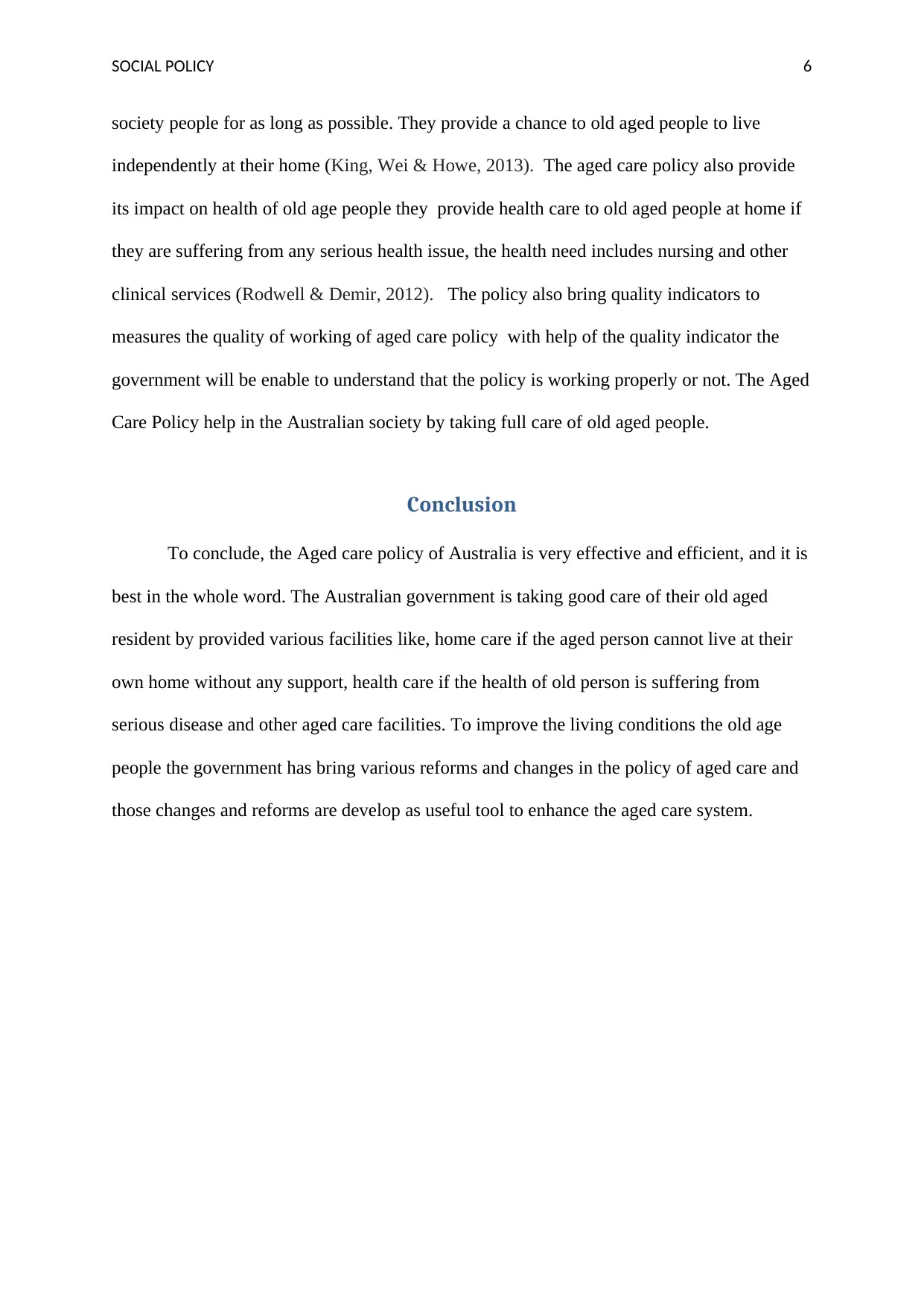
SOCIAL POLICY 6
society people for as long as possible. They provide a chance to old aged people to live
independently at their home (King, Wei & Howe, 2013). The aged care policy also provide
its impact on health of old age people they provide health care to old aged people at home if
they are suffering from any serious health issue, the health need includes nursing and other
clinical services (Rodwell & Demir, 2012). The policy also bring quality indicators to
measures the quality of working of aged care policy with help of the quality indicator the
government will be enable to understand that the policy is working properly or not. The Aged
Care Policy help in the Australian society by taking full care of old aged people.
Conclusion
To conclude, the Aged care policy of Australia is very effective and efficient, and it is
best in the whole word. The Australian government is taking good care of their old aged
resident by provided various facilities like, home care if the aged person cannot live at their
own home without any support, health care if the health of old person is suffering from
serious disease and other aged care facilities. To improve the living conditions the old age
people the government has bring various reforms and changes in the policy of aged care and
those changes and reforms are develop as useful tool to enhance the aged care system.
society people for as long as possible. They provide a chance to old aged people to live
independently at their home (King, Wei & Howe, 2013). The aged care policy also provide
its impact on health of old age people they provide health care to old aged people at home if
they are suffering from any serious health issue, the health need includes nursing and other
clinical services (Rodwell & Demir, 2012). The policy also bring quality indicators to
measures the quality of working of aged care policy with help of the quality indicator the
government will be enable to understand that the policy is working properly or not. The Aged
Care Policy help in the Australian society by taking full care of old aged people.
Conclusion
To conclude, the Aged care policy of Australia is very effective and efficient, and it is
best in the whole word. The Australian government is taking good care of their old aged
resident by provided various facilities like, home care if the aged person cannot live at their
own home without any support, health care if the health of old person is suffering from
serious disease and other aged care facilities. To improve the living conditions the old age
people the government has bring various reforms and changes in the policy of aged care and
those changes and reforms are develop as useful tool to enhance the aged care system.
Paraphrase This Document
Need a fresh take? Get an instant paraphrase of this document with our AI Paraphraser
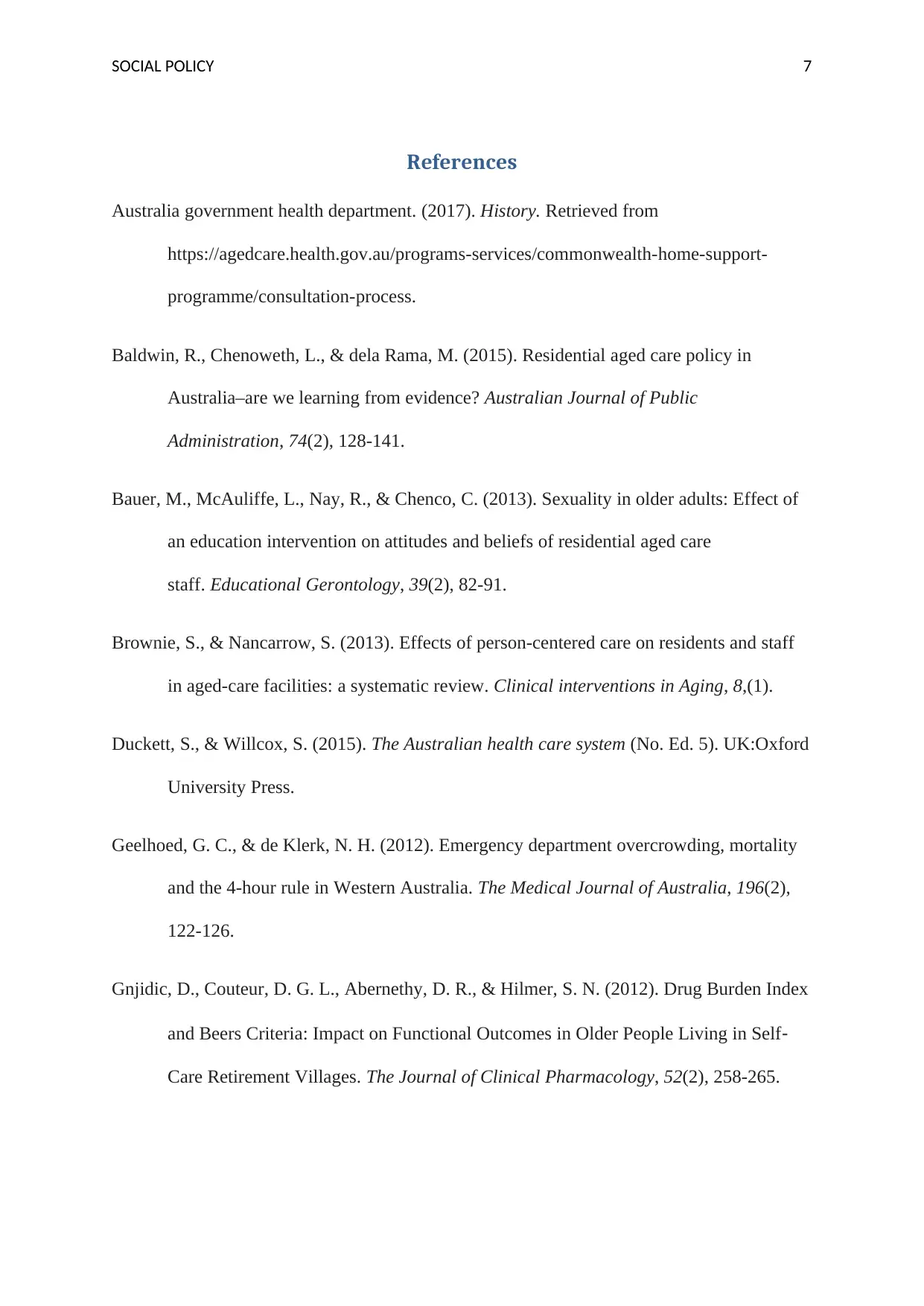
SOCIAL POLICY 7
References
Australia government health department. (2017). History. Retrieved from
https://agedcare.health.gov.au/programs-services/commonwealth-home-support-
programme/consultation-process.
Baldwin, R., Chenoweth, L., & dela Rama, M. (2015). Residential aged care policy in
Australia–are we learning from evidence? Australian Journal of Public
Administration, 74(2), 128-141.
Bauer, M., McAuliffe, L., Nay, R., & Chenco, C. (2013). Sexuality in older adults: Effect of
an education intervention on attitudes and beliefs of residential aged care
staff. Educational Gerontology, 39(2), 82-91.
Brownie, S., & Nancarrow, S. (2013). Effects of person-centered care on residents and staff
in aged-care facilities: a systematic review. Clinical interventions in Aging, 8,(1).
Duckett, S., & Willcox, S. (2015). The Australian health care system (No. Ed. 5). UK:Oxford
University Press.
Geelhoed, G. C., & de Klerk, N. H. (2012). Emergency department overcrowding, mortality
and the 4-hour rule in Western Australia. The Medical Journal of Australia, 196(2),
122-126.
Gnjidic, D., Couteur, D. G. L., Abernethy, D. R., & Hilmer, S. N. (2012). Drug Burden Index
and Beers Criteria: Impact on Functional Outcomes in Older People Living in Self‐
Care Retirement Villages. The Journal of Clinical Pharmacology, 52(2), 258-265.
References
Australia government health department. (2017). History. Retrieved from
https://agedcare.health.gov.au/programs-services/commonwealth-home-support-
programme/consultation-process.
Baldwin, R., Chenoweth, L., & dela Rama, M. (2015). Residential aged care policy in
Australia–are we learning from evidence? Australian Journal of Public
Administration, 74(2), 128-141.
Bauer, M., McAuliffe, L., Nay, R., & Chenco, C. (2013). Sexuality in older adults: Effect of
an education intervention on attitudes and beliefs of residential aged care
staff. Educational Gerontology, 39(2), 82-91.
Brownie, S., & Nancarrow, S. (2013). Effects of person-centered care on residents and staff
in aged-care facilities: a systematic review. Clinical interventions in Aging, 8,(1).
Duckett, S., & Willcox, S. (2015). The Australian health care system (No. Ed. 5). UK:Oxford
University Press.
Geelhoed, G. C., & de Klerk, N. H. (2012). Emergency department overcrowding, mortality
and the 4-hour rule in Western Australia. The Medical Journal of Australia, 196(2),
122-126.
Gnjidic, D., Couteur, D. G. L., Abernethy, D. R., & Hilmer, S. N. (2012). Drug Burden Index
and Beers Criteria: Impact on Functional Outcomes in Older People Living in Self‐
Care Retirement Villages. The Journal of Clinical Pharmacology, 52(2), 258-265.
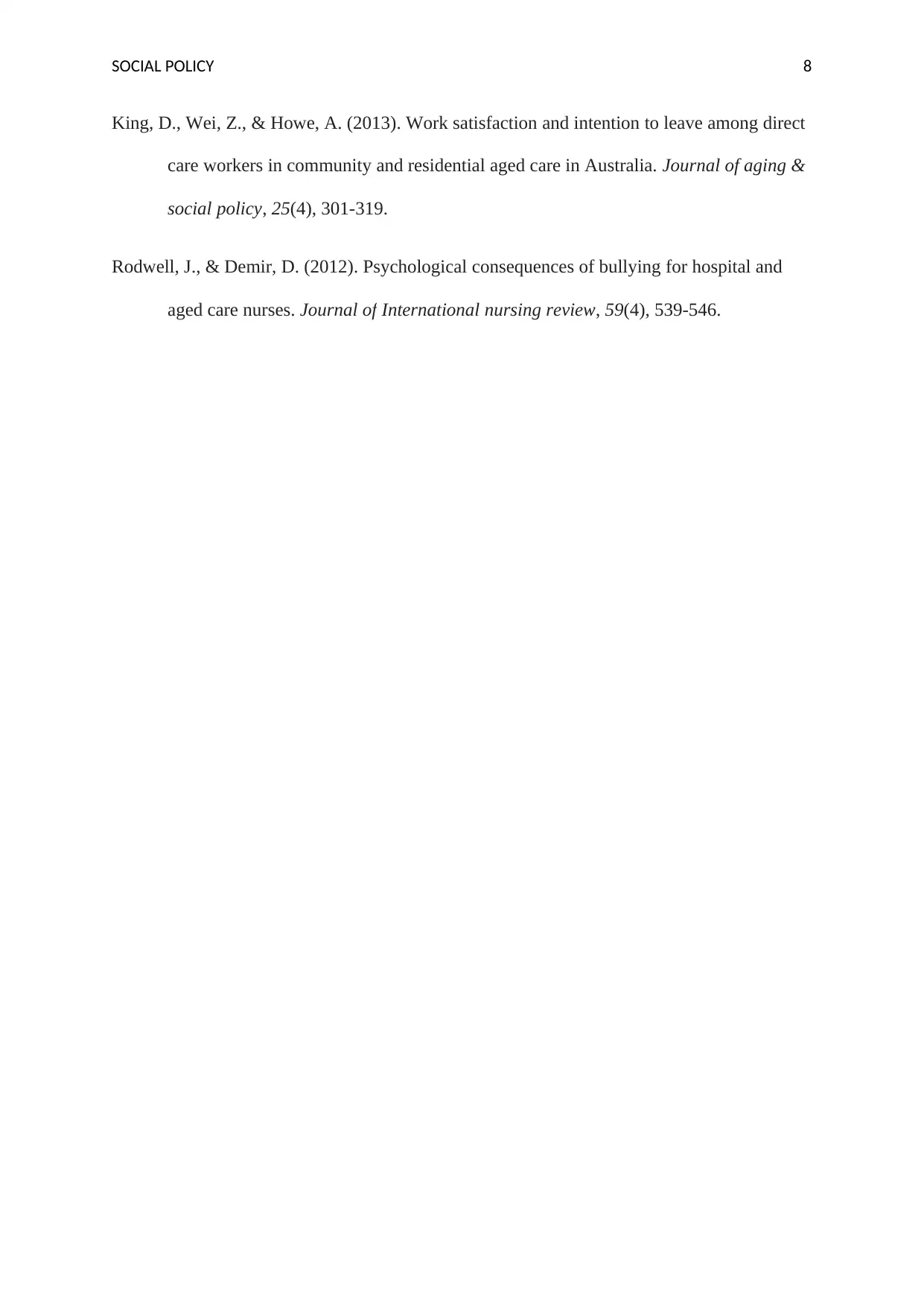
SOCIAL POLICY 8
King, D., Wei, Z., & Howe, A. (2013). Work satisfaction and intention to leave among direct
care workers in community and residential aged care in Australia. Journal of aging &
social policy, 25(4), 301-319.
Rodwell, J., & Demir, D. (2012). Psychological consequences of bullying for hospital and
aged care nurses. Journal of International nursing review, 59(4), 539-546.
King, D., Wei, Z., & Howe, A. (2013). Work satisfaction and intention to leave among direct
care workers in community and residential aged care in Australia. Journal of aging &
social policy, 25(4), 301-319.
Rodwell, J., & Demir, D. (2012). Psychological consequences of bullying for hospital and
aged care nurses. Journal of International nursing review, 59(4), 539-546.
⊘ This is a preview!⊘
Do you want full access?
Subscribe today to unlock all pages.

Trusted by 1+ million students worldwide
1 out of 9
Related Documents
Your All-in-One AI-Powered Toolkit for Academic Success.
+13062052269
info@desklib.com
Available 24*7 on WhatsApp / Email
![[object Object]](/_next/static/media/star-bottom.7253800d.svg)
Unlock your academic potential
Copyright © 2020–2025 A2Z Services. All Rights Reserved. Developed and managed by ZUCOL.




